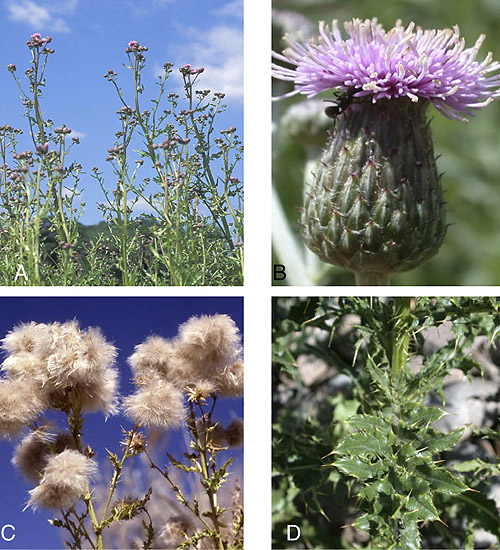Canada Thistle
 (Cirsium arvense)
(Cirsium arvense)
Common Names: Californian Thistle, Canadian Thistle, Creeping Thistle, Field Thistle, Perennial Thistle
History
Despite its name, the Canada Thistle is native to Europe and was accidentally introduced to North America in the 17th century.
Physical Description
General: A tall, erect, spiny perennial plant that grows to 120 cm (4') tall. It has a vigorous and wide-spreading root system. The stems are ridged and hairy.
Leaves: The leaves are alternate and are oblong to lance shaped.They are irregularly lobed with very prickly edges.
Flowers and Fruit: The flowers are purple to white and up to 1.5 cm (1/2") in diameter. The flowers are in loose clusters at the end of the branches. The fruits are small, single-seeded and dry, 2.5-5 mm (1/10-1/5") long and have a feathery structure (pappus) attached to the base which lets them float through the air. The seeds can remain viable for over 20 years.

[A] Several Canada thistle plants infesting a field. [B] A flower head. [C] The seeds, each with a with feathery pappus. [D] Close up of the prickly leaves and stem.
Photos: [A] S. Dewey, Utah State University Bugwood.org [B] M. E. Harte Bugwood.org [C] J.Schmidt NPS Photo [D] M. E. Harte Bugwood.org
Threat
Canada Thistle crowds out native species and reduces crop and forage yields. It is also a pest of natural and disturbed areas.
Distribution
Canada Thistle is widespread in Manitoba and most of North America.
Resources
Alberta Invasive Plant Council Fact Sheet
Â
Back to Terrestrial Invasive Species List
Â
© Copyright 2004-2024 - CMS Made Simple
This site is powered by CMS Made Simple version 1.4.1


